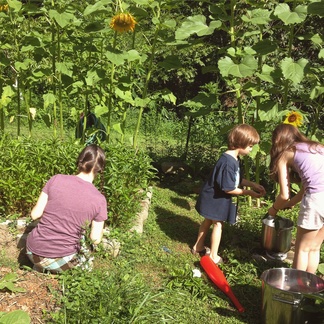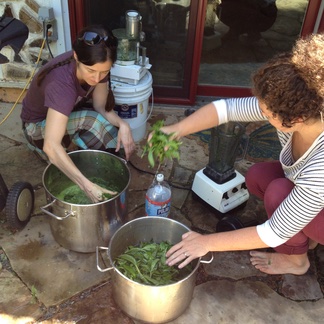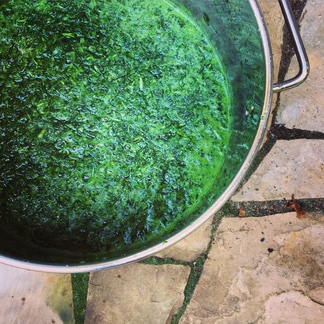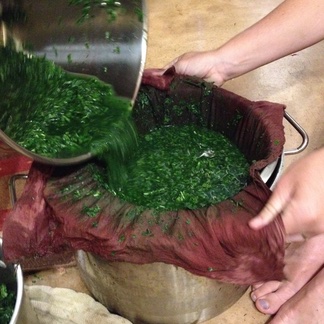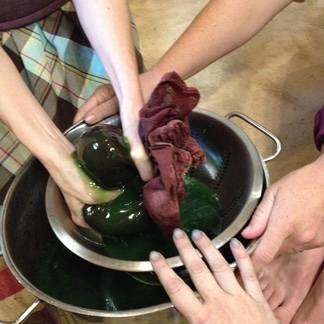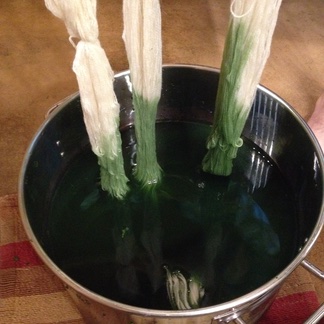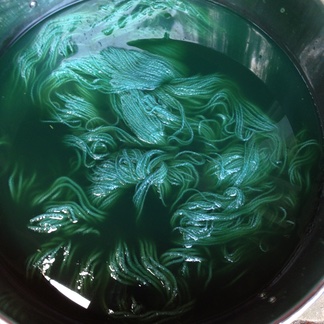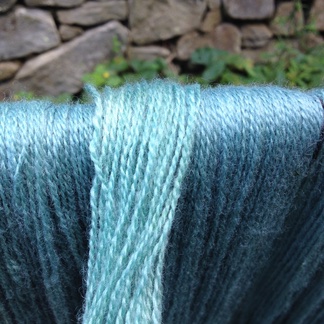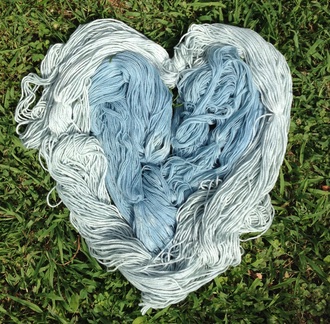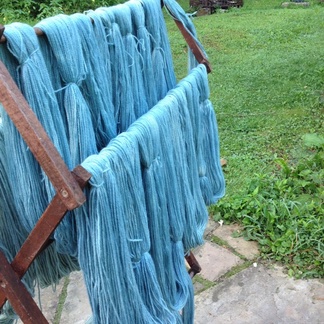 The dye garden is doing fabulously this year!  The Hopi sunflowers are over 10 feet tall, the madder is prolific, and the indigo is lush.  Our indigo (Dyer’s Knotweed or Polygonum tinctorium) grows very well in the North Carolina mountains and this week was indigo harvest time!
The dye garden is doing fabulously this year!  The Hopi sunflowers are over 10 feet tall, the madder is prolific, and the indigo is lush.  Our indigo (Dyer’s Knotweed or Polygonum tinctorium) grows very well in the North Carolina mountains and this week was indigo harvest time!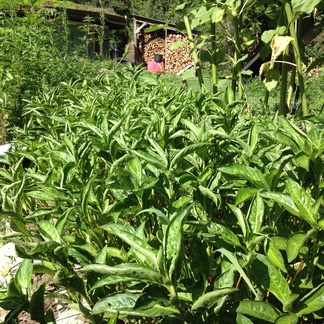
Nikki (my Fern Fiber partner in crime), my kids, and I worked quickly to cut the stems above the 3rd or 4th node and strip the leaves off.  (Cutting the stem here lets the indigo grow back for a second harvest in the fall!)  The leaves were weighed and then added to some cold water.  We were hoping to get 4 pounds of leaves to dye 2 pounds of yarn.  But, we ended up with only 3 pounds.
We were joined by our friend, Sarah, as we began chopping up the leaves in the blender with more cold water and blending them to a pulp.
We stirred in 3/4 cup white vinegar. Â This is supposed to help pull out the pigment and keep it from breaking down too quickly. Â We let this sit for 30 minutes.
Then we strained it through muslin cloth and put the strained liquid to the side in my super large dye pot while we soaked the plant matter a second time in more cold water and let it sit for another 30 minutes.
Once the second batch was strained, all the liquid went into the big pot…
and the yarn was added. Â (This is organic merino wool that we soaked overnight in water.)
After one hour of soaking, you can see the color of the bath and yarn had become more blue.
We gently squeezed the yarn out and hung it up to dry. Â Within seconds, you could see the air oxidizing the pigment and changing it to blue!
The lighter blue on top was just out of the dye bath. Â The darker had been out in the air for a few minutes. Â Look at the difference from the picture above, too!
Drying in the shade, you can still see all of the color dripping onto the rock below!
We had been worried that we wouldn’t get enough color for the amount of yarn we wanted to dye. Â I’d read that you should have 2 times the amount of plant material and we only had 1.5. Â Despite this, there was still so much color left in the dye bath, we decided to add more yarn (another full pound that we’d had soaked and ready… just in case). Â This sat in the dye for another hour. Â The yarn on the left was from the second batch. Â Only slightly lighter, but still super gorgeous!
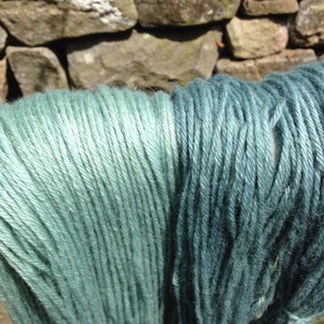 There was still so much color in the dye bath, but no more yarn to toss in there. Â I decided to put the strained indigo plant material back in the bath to see if I could ferment it a bit to pull more color out. Â I’ll let keep you posted on those results!
There was still so much color in the dye bath, but no more yarn to toss in there. Â I decided to put the strained indigo plant material back in the bath to see if I could ferment it a bit to pull more color out. Â I’ll let keep you posted on those results!
The yarns cure/dry for at least 2 days before they are washed.  Once the are dried again and reskeined, we’ll put them in our Fern Fiber naturally dyed yarn store (well, not all of them.  Sometimes us dyers take our payment in skeins of yarn!! 🙂 )
PS. I know I haven’t been posting nearly as much on my blog, but I do have a pretty active Instagram account.  If you’d like to follow my homesteading, homeschooling, and fiber frenzy, you can also find me at @ninja.chickens and our Fern Fiber naturally dyed yarns can be followed at @fernfiber.
